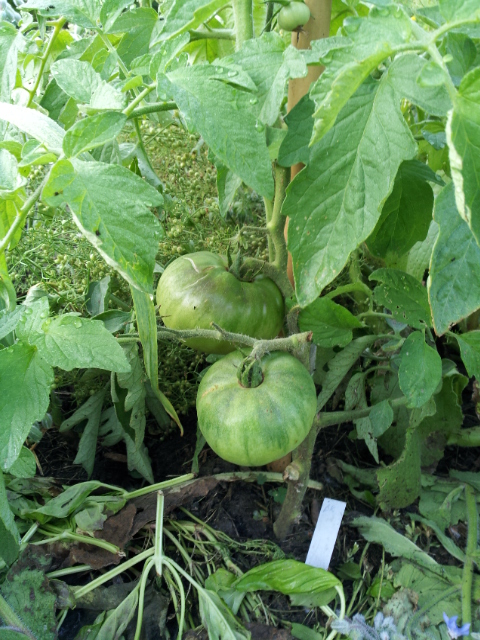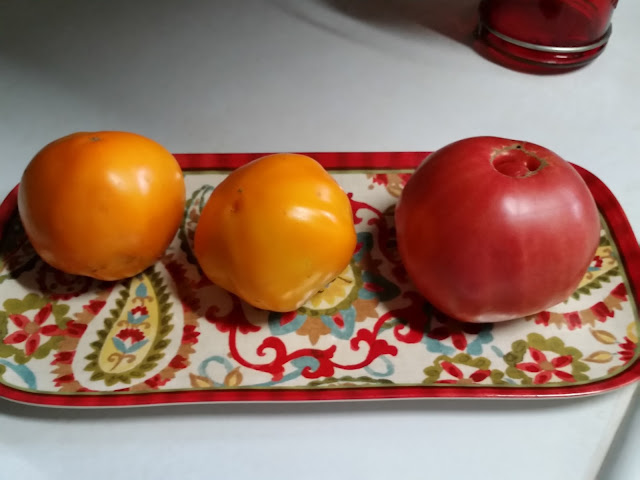Now, what about the taste? I never eat fresh tomatoes any season but summer. The reason is that anything I can get in a grocery store out of season is a very poor substitute. Taste, texture, look. They're just not worth it.
But, when spring garden planting time is here, perhaps the biggest and most important decision to me is what kind of tomatoes I'm going to plant. I'm looking for a slicing tomato with just the right amount of acidity and sweetness. Bacon and tomato sandwiches! Tomato slices and cottage cheese! Tomato slices with fresh basil! Tomato slices and fried okra!
I actually found that perfect tasting tomato the first year of my garden when I planted a "purple" tomato: Black Krim. It didn't perform so well, but really, none of my tomato plants were outstanding that year, and I may just try it again next year, even though it tends to have a lot of waste from cracking on the stem end. They looked great when they were green, but I had to waste about half the tomato due to cracking.
When ripe, they were a gorgeous dark burgundy red. Why I don't have any pictures of a ripe one, I don't know. Here's someone else's picture of Purple Cherokee, and that's pretty much what Black Krim looked like.
I do have a picture of a Black Krim tomato sliced up. As you can see, the largest slice has a lot of hard green area. That slice was taken from the middle of the tomato. So, not a very good ratio of edible goodness to waste.
Typical web advice says cracking results from uneven watering. That makes sense, but I hand watered the first year, and I watered very evenly. I also watered each of several varieties the same, and the purple ones were the only ones to crack. Baker Creek Seed Company comments on Black Krim are all positive, and only one says "They tend to crack easily." As I said, I think I'll try them again.
The Beefsteaks were large, and produced well, but not particularly tasty.
As you can see, I was growing my tomatoes on poles, staking them and pruning regularly. It was a whole lot of work. I liked the looks of the bamboo poles in my garden, versus setting up wire cages, but the main problem turned out to be keeping them upright given the heavy rains and high winds we typically have in spring. After two years of righting heavy, fallen tomato plants (which didn't always fall without damage, needless to say), I used cages this year.
You might also notice the severe leaf curling on that plant. Early on, I thought this was happening because of herbicide damage from nearby field crop sprays. After doing some research, I decided it was most likely due to the cool, damp weather we were having.
Shepherd's hooks, with their buttressed feet may have stood better than bamboo poles if we didn't have so much rain and wind. I'll never know.
Neither the Brandywine red or yellow plants I grew that first year produced a single tomato. Mortgage Lifter (red, but you can also get yellow) was a poor producer, despite its name. Hillbilly (kind of mottled yellow and red) and Mr. Stripey (a striped one - who would have guessed? - similar to Hillbilly) both did okay. Several people remarked how delicious Mr. Stripey is, and at least three I know started planting it. I planted it again last year, but I didn't get lots of production either year. I might try it again, since it's possible Mr. Stripey doesn't do well staked.
I planted two roma style tomatoes the first year: Black Icicle (purple) and Amish Paste (red). They were okay, but they're not slicers, and I don't make sauces. I thought I might that first year, but I was overly ambitious. No more shall I waste space and time on sauce tomatoes.
The second year, the only repeats I planted were Mr. Stripey and Golden Jubilee. Golden Jubilee is one of my favorites. It's yellow, so not my favorite tomato color, but, boy, is it tasty. I've planted it all three years, and it's produced very well each time.
Golden Jubilee and Missouri Pink Loveapple
New varieties I tried last year were Black Prince, Rutger, and Cherokee Purple. Black Prince and Cherokee Purple are both purple tomatoes, and I was eager to find one that didn't crack so much but tasted as good as Black Krim. The Cherokee Purple fruits cracked just like Black Krim, and I didn't think they were as tasty. I didn't get much out of Black Prince. The fruits that it produced were kind of small. Rutger was so-so, and the fruits were also smallish.
Black Prince
This year, I planted Golden Jubilee (of course), Missouri Pink Loveapple (a "potato-leaf" tomato), Old Italian (red) and Brave General (red).
The two red varieties are large, good slicers, but nothing wonderful in the taste department, as far as I'm concerned. Missouri Pink Loveapple, on the other hand, is not only a nice large slicer, but it's very, very tasty. This and Golden Jubilee are probably going to be in my garden every year.
What tomatoes we can't eat and I don't give away, I freeze to use in winter soups, so I like to plant lots of tomatoes.
I blanch them, slice them, cut myself, place them on a cookie sheet to freeze, and then transfer them to freezer storage bags. I left my good knives with my sister one day some months ago to take to the knife sharpening man at the farmers' market. He did such a good job that I cannot use my small paring knife without cutting myself. The tip is incredibly sharp. I've only used it three times since getting it sharpened, and I've cut myself with it each time, even though I'm trying to be extra careful. I'm starting to become afraid of this knife.
I have two Brave General plants growing. I put one in a spot that gets some shade through a large part of the day just to see how it would grow. While it's not nearly as bushy as the one in full sun, it has about the same number of fruits, and they're just as large. In fact, they're ripening sooner, and I suspect it has to do with the shade, since I read that tomatoes ripen between 50 and 80 degrees, and it's only been under 80 at night, never once the sun comes up, for a very long time this summer. The fact that this plant has as many fruits may be due to something else, though, as the one in full sun has competition from the other tomatoes I crammed in that space, and the one with shade is by itself. At any rate, I won't be afraid to put future plants in some of the shadier areas of my garden.
I start my tomatoes indoors, and since I always plan for failure, I have too many plants each year. But they're as fun to give away as they are to grow
Keeping on top of tomato hornworm damage requires keen eyes and persistence. Watching for the obvious damage they do clues me in that they're here, but I can usually only see them when they've gotten big enough to devour lots of leaves, and that doesn't take long at all. They can strip a plant in no time. Tomatoes grow vigorously in summer, however, and they've always managed to make up for the loss. The problem comes if I don't get to the caterpillars before they strip leaves that shade ripening tomatoes, causing loss to sun scald.
I can't believe I didn't take any pictures of the hornworms. They're disgusting and fascinating at the same time. They're also the same color as the tomato plant, and tend to hang along the underside of the leaf ribs, so they're not always obvious until they've gotten huge. Signs of their presence, however are pretty obvious. The leaves will be eaten down to the main rib, leaving a Charlie Brown Christmas tree effect, and worm poop is distinctive. Yuck.
I pick off the worms when I see them and toss them in my kill jar (which is just a plastic lidded container with a kleenex onto which I've poured a little acetone fingernail polish remover, in case this is your first post). I used to just pick the worm itself, but now I pinch off the leaf they're on and put the whole thing in the jar, after having been bitten by a great big one. I had no idea they'd bite. It won't kill you, but it's not pleasant. Here's a picture from the Farmer's Almanac, and you can see that person is already wise. There are some nice pictures on that page.
It's all worth it.












0 comments:
Post a Comment
Many thanks for your interest and your comments.